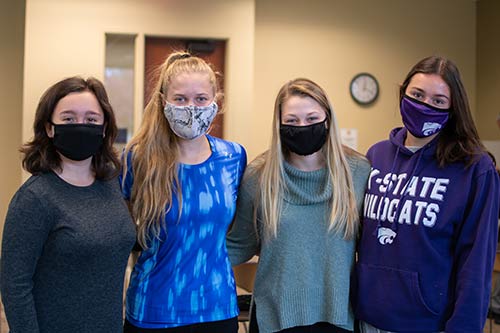October 27, 2020
CVM early-admit students explore public health in the spirit of Sherlock Holmes

It's public health, my dear Watson! A group of early-admit veterinary students has the opportunity to study 19th century discoveries in microbiology, epidemiology and public health science that coincided with literary classics, including Sir Arthur Conan Doyle's "Sherlock Holmes."
The University Honors Program course, titled Human and Veterinary Public Health in the Age of Sherlock Holmes, is taught by Justin Kastner, former director of the program and associate professor in the diagnostic medicine and pathobiology department.
"For the last 20 years I have studied late 19th-century trade disputes related to animal disease and food safety," Kastner said. "This time period coincides with what I call 'the age of Sherlock Holmes,' or, more aptly, the age of Arthur Conan Doyle. When I was studying public health at the University of Edinburgh, I fell in love with the history of public health."
The topics covered in the course are right down Kastner's alley, who has studied at two British universities.
"Edinburgh is, incidentally, the birthplace of Doyle, and my wife Susie and I lived just a few minutes' walk from two of his homes," Kastner said. "Doyle's interest in disease causation and public health mysteries were no doubt inspired in part by his time in Edinburgh, and certainly during his time as a medical student at the University of Edinburgh.
Kate Lewis, Alexis Justice, Lucy Fischer and Sophie Sutton are early-admit students and aspiring veterinarians enrolled in Kastner's course.
"One of the best parts about the class so far is the historical perspective it is giving me of the veterinary profession," Lewis said. "We've learned about the condescending attitudes toward vets in the 19th century and how it greatly contrasts with attitudes toward vets today."
The students' coursework covers late 19th-century British, as well as early 20th-century Kansas, contributions to professional identities, roles and rivalries in multiple professions at the nexus of human medicine, veterinary medicine and public health.
"This course is helping me in my path to becoming a veterinarian because it is teaching me about the past endeavors of veterinarians and medical professionals in the area of public health, and how the One Health Initiative began," Justice said. "It is also very helpful in drawing connections between the things that happened in the past to what is occurring in modern times."
"Knowing how much of an impact veterinary medicine has had in the history of the United States and other countries has further convinced me of the importance of receiving my Doctor of Veterinary Medicine," Fischer said. "I've learned a lot about the One Health Initiative and how veterinarians play a key role in protecting the health of not only animals but also people and the environment as well."
Other material in the course includes reflections on contemporary public health threats in light of lessons learned from historical and presently unfolding events, such as COVID-19 and pandemic influenza during World War I.
"Veterinary medicine is a field that is constantly evolving and requires you to continue to learn every day," Sutton said. "I am even more excited now to become a veterinarian and work with doctors to solve epidemiological problems."
